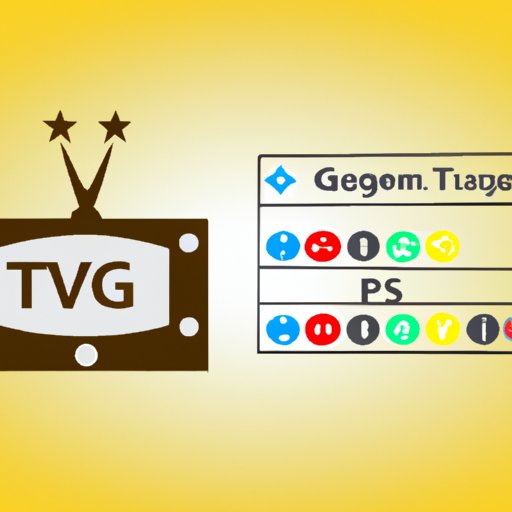Introduction
With so many television programs and movies available to watch, it can be difficult to determine which ones are appropriate for children. One way to assess if a show or movie is suitable for your family is to look at its TV rating. But what does TV-G mean? This article will explore the meaning of the TV-G rating, as well as provide an overview of the TV rating system, examples of TV shows and movies rated TV-G, tips for parents to find quality programming, and more.
Exploring the Meaning of TV-G: What Does it Mean?
The TV-G rating is one of several ratings used to classify television programs and movies by their suitability for viewers of all ages. The TV-G rating indicates that the content of the program or movie is appropriate for general audiences, including young children.
Description of TV-G Rating
The TV-G rating is assigned to programs and movies that contain little or no violence, sexual activity, nudity, strong language, or provocative themes. The content should be suitable for all viewers, including young children. Programs and movies with this rating may include some mild suggestive material and/or brief language, but they should not contain any offensive or potentially disturbing content.
Examples of TV Shows and Movies Rated TV-G
Some popular examples of programs and movies rated TV-G include Disney’s “Cars”, Pixar’s “Toy Story”, Nickelodeon’s “SpongeBob SquarePants”, PBS Kids’ “Arthur”, DreamWorks Animation’s “Kung Fu Panda”, and Universal Pictures’ “Despicable Me”. These are just a few of the many shows and movies that have been given the TV-G rating.
Unpacking the Definition and Rating System Behind TV-G
Understanding the TV Parental Guidelines
The TV Parental Guidelines are a set of voluntary standards that were developed by the television industry in order to help parents make informed decisions about the television programming their children watch. The guidelines are divided into four ratings categories: TV-Y (all children), TV-Y7 (older children), TV-PG (parental guidance suggested), and TV-14 (parents strongly cautioned).
How Ratings are Determined
Ratings are determined by a panel of experts who review the content of each program or movie before assigning it a rating. The panel looks for potential issues such as violence, sexual activity, nudity, strong language, and provocative themes. The ratings are based on the age of the target audience and the level of exposure they may have to potentially objectionable content.
How to Choose Appropriate Content for Children with TV-G
Tips for Parents to Find Quality Programming
When choosing appropriate content for children, parents should look for programs and movies that are rated TV-G. However, it is important to remember that not all programs and movies with this rating are necessarily appropriate for all children. Parents should also take the time to watch the content with their children to ensure it is suitable for them.
Resources to Help Parents Select Appropriate Content
In addition to the TV Parental Guidelines, there are other resources available to help parents select appropriate content. Many websites offer reviews of programs and movies, as well as ratings and parental advisory warnings. Additionally, there are organizations such as Common Sense Media that provide helpful information to parents regarding the appropriateness of television programming and movies.
Understanding the Difference Between TV-Y, TV-PG, and TV-G Ratings
Explanation of Each Rating
The TV-Y rating is intended for all children, including those under the age of 7. Programs and movies with this rating may contain some mild suggestive material and/or brief language, but they should not contain any offensive or potentially disturbing content. The TV-PG rating is intended for older children and suggests that parents should use discretion when allowing their children to watch the content. Finally, the TV-G rating is intended for general audiences and indicates that the content of the program or movie is suitable for all viewers, including young children.
Comparing the Different Ratings
It is important to understand the differences between the various ratings in order to choose appropriate content for children. The TV-Y rating is the most restrictive, followed by TV-G, then TV-PG. While the TV-G rating is suitable for all viewers, the TV-PG rating suggests that parents should use discretion when allowing their children to watch the content.
A Parent’s Guide to TV-G: What to Look for in Quality Programming
Identifying Good Quality Programs
When looking for quality programming for children, parents should look for shows and movies that are rated TV-G. Additionally, parents should look for programs and movies that are educational, entertaining, and age-appropriate. It is also important to consider the messages that the content conveys and whether or not the content promotes positive values.
Evaluating Potential Content
Parents should also evaluate potential content before allowing their children to watch it. This includes watching the program or movie with their children and discussing any questions or concerns they may have. Additionally, parents should read reviews and ratings of the content to determine if it is suitable for their children.
Conclusion
The TV-G rating is one of several ratings used to classify television programs and movies by their suitability for viewers of all ages. The TV-G rating indicates that the content of the program or movie is appropriate for general audiences, including young children. When selecting content for children, parents should look for programs and movies that are rated TV-G and are educational, entertaining, and age-appropriate. Additionally, parents should take the time to watch the content with their children to ensure it is suitable for them. By understanding the definition and rating system behind TV-G, parents can make informed decisions about the television programming their children watch.


